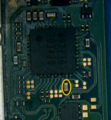More actions
| Nintendo Switch | |
|---|---|
| Manufacturer | Nintendo |
| Code name | HAC-001 and HAC-001(-01) |
| Release date | March 3, 2017 |
| Device type | Game Console |
This article is a stub. You can help Repair Wiki grow by expanding it
Guides
Explanatory Guides
| Type | Difficulty | |
|---|---|---|
| Diagnosing Power Draws on Nintendo Switch | Troubleshooting/Diagnostics | 2. Medium |
| Nintendo Switch CPU capacitors | Circuit | 1. Easy |
| Nintendo Switch No Fan Spin Voltage Injection Method | Method | 2. Medium |
| Nintendo Switch Not Charging | Troubleshooting/Diagnostics | 2. Medium |
Repair Guides
Create a Guide
Device pictures
-
Nintendo Switch
PCB pictures
-
Nintendo Switch Fan Pinout
-
CPU capacitor next to the SOT-323 IC near MAX17050
-
M92T36 CPU Capacitor
Reference measurements (also schematics if available)
Please consider contributing pictures to this section!
More Information/External Sources
This page applies to the HAC-001 and HAC-001(-01) models.
Both of them mostly use the same ICs as each other. Please refer to the parts list below.
Some of the board revisions have a Diode pack, which can cause issues. The diode packs (or commonly referred to as diode arrays) can be removed without affecting the functionality of the console. They do not need to be replaced and removing them will reduce the number of future failure points from the console.
The HAC-001(-01) was released in 2019, and is a refresh of the HAC-001 model, characterized by a red box, better battery life and lower power draw.
If your Switch is stuck on a blue screen, this is traditionally a failure of the eMMC but could also be ram or CPU related. Often occurs if there is visible bending or bowing to the unit. A reflow sometimes works but the longevity of the repair is varying. A reball may be required. (If you apply pressure to both ram chips and it boots to Nintendo screen, RAM chips may need reball)
Before delving too much into a repair it might be a good idea to check the known CPU caps for shorts, at the moment if those are shorted it is general consensus that the CPU is dead.




